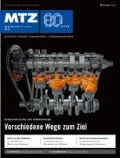Zusammenfassung
Die Steuerung der Verbrennung durch Selbstzündung zeigt Vorteile bezüglich Senkung der NOx-Emission und Prozessstabilität, sowohl bei Otto- als auch bei Dieselmotoren. Im ersten Teil dieses gemeinsamen Beitrags der Westsächsischen Hochschule Zwickau und der Universität Paris erfolgt eine thermodynamische Betrachtung der Selbstzündvorgänge, die sowohl den Brennverlauf als auch die Zustandsänderungen während der Verbrennung beeinflussen. Im zweiten Teil des Beitrages in der nächsten MTZ-Ausgabe werden die theoretischen Betrachtungen durch experimentelle Untersuchungen veranschaulicht.
Literaturhinweise
Stan, C.: Direct Injection Systems — The Next Decade in Engine Technology. SAE International, Society of Automotive Engineers, Warrendale, PA, USA, 2002, ISBN 0-7680-1070-5, SAE Order No. RR-015
Milovanovic, N.; Chen, R.: A Review of Experimental and Simulation Studies on Controlled Auto-Ignition Combustion. In: SAE Paper 2001-01-1890, 2001
Adzic, M.; Milovanovic, N.: Homogeneous Charge Compression Ignition (HCCI) Combustion — Challenge, Benefits and Future Engine Applications. Sixth International Conference on Technologies and Combustion for a Clean Environment, Porto, July 2001
Stan, C.; Hilliger, E.: Pilot Injection System for Gas Engines Using Electronically Controlled Ram Tuned Diesel Injection. Twenty-second CIMAC Congress, Copenhagen, Mai 1998
Stan,C.: Direct Injection Systems for Spark Ignition and Compression Ignition Engines. SAE International, Society of Automotive Engineers, Warendale, PA, USA, ISBN 0-7680-0610-4, SAE Order No. R-289
Morimoto, S.S.; Kawabata, Y.; Sakurai, T.; Amano, T.: Operating Characteristics of a Natural Gas-Fired Homogeneous Charge Compression Ignition Engine (Performance Improvement Using EGR). In: SAE Paper 2001-01-1034, 2001
Christensen, M.; Johansson, B.: Influence of Mixture Quality on Homogeneous Charge Compression Ignition. In: SAE Paper 982454, 1998
Au, M.Y.; Girard, J.W.; Dibble, R.; Flo- wers, D.; Aceves, S.M.; Martinez-Frias, J.; Smith, R.; Seibel, C.; Maas, U.: 1.9 Liter Four Cylinder HCCI Engine Operation with Exhaust Gas Recirculation. In: SAE Paper 2001-01-1894, 2001
Homogeneous Charge Compression Ignition (HCCI) Combustion. SAE SP —1623, 2001
HCCI Combustion. SAE SP-1627, 2001
Zheng, J.; Yang, W.; Miller, D.L.; Cernansky, N.P.: Prediction of Pre-Ignition Reactivity and Ignition Delay for HCCI Using a Reduced Chemical Kinetic Model. In: SAE Paper 2001-01-1025, 2001
Kong, S.C.; Marriott, C.D.; Reitz, R.D.; Christensen, M.: Modeling and Experiments of HCCI Engine Combustion Using Detailed Chemical Kinetics with Multidimensional CFD. In: SAE Paper 2001-01-1026, 2001
Flowers, D.; Aceves, S.; Westbrook, C.K.; Smith, J.R.; Dibble, R.: Detailed Chemical Kinetic Simulation of Natural Gas HCCI Combustion: Gas Composition Effects and Investigation of Control Strategies. In: Journal of Engineering for Gas Turbines and Power, 2001, 123, S. 433–439
Cernansky, N.P.; Green, R.M.; Pitz, W.J.; Westbrook, C.K.: Chemistry of Fuel Oxidation Preceding End-Gas Auto Ignition. In: Combustion Science and Technology, 1986, 50 (No. 1–3), 3–25
Author information
Authors and Affiliations
Rights and permissions
About this article
Cite this article
Stan, C., Guibert, P. Verbrennungssteuerung durch Selbstzündung. MTZ Motortech Z 65, 56–62 (2004). https://doi.org/10.1007/BF03227159
Issue Date:
DOI: https://doi.org/10.1007/BF03227159

